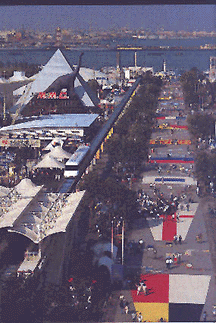High Speed Surface Transport (HSST) : A Japanese Maglev Technology
HSST is a maglev transportation system that has been developed in Japan and is now being offered around the world by the HSST Development Corporation. Two of the major shareholders in this corporation are Japan Airlines and Nagoya Railroad Co. Ltd. This corporation was established in 1993. A brief history of the HSST is available. So far as is known, two projects have received final approval and several others are under study in various parts of the world. Both intra-urban (HSST-100) and inter-city (HSST-200) applications are envisioned. Speeds of up to 200 kph are believed to be within the capabilities of this technology. It produces no noise, is vibration free and low energy use is claimed.
![[view of hsst train]](hsst6.gif) The next four
photos were taken at an exposition held in 1989 in Yokohama, Japan. The first is an aerial
view of the 500 meter exposition track. The second shows the HSST-5 vehicle which consists
of two cars and 158 seats. The third is another view of the HSST-5 vehicle and the fourth
shows the Seaside Park Station at the exposition. The Japanese Ministry of Transport gave
approval to the HSST-100 technology in 1993 meaning that it has been found to be safe for
public service. It is not known if the intercity version (HSST-200) has also been approved
as yet.
The next four
photos were taken at an exposition held in 1989 in Yokohama, Japan. The first is an aerial
view of the 500 meter exposition track. The second shows the HSST-5 vehicle which consists
of two cars and 158 seats. The third is another view of the HSST-5 vehicle and the fourth
shows the Seaside Park Station at the exposition. The Japanese Ministry of Transport gave
approval to the HSST-100 technology in 1993 meaning that it has been found to be safe for
public service. It is not known if the intercity version (HSST-200) has also been approved
as yet.

![[HSST-5 vehicle on track]](hsst1.gif)
![[HSST-5 vehicle on track]](hsst2.gif)
![[photo of hsst station at
exposition]](hsst3.gif)
The HSST is magnetically-levitated (not supported by wheels) and is propelled by a linear induction motor (LIM), not by conventional rotary electric motors. The levitation method utilizes ordinary direct-current electromagnets that are attached to the bottom of the vehicle and lift it upward toward a steel rail. A gap sensor measures the gap (distance between the rail and magnet cores) and an electronic circuit amplifier functions to control the current to the electromagnets in order to keep the gap at 8 mm. The LIM is used for HSST propulsion. Its primary coil is attached to the vehicle side (in the module) and the secondary side (aluminum reaction plate) is attached to the top of an iron rail. Linear motors can smoothly change the train speed by varying the voltage and frequency of the current supplied to the motors.
The HSST has no moving parts other than its air conditioning system. There would not be any wear of guideway parts so maintenance of the guideway should be much less than conventional rail systems.
Here is a recent news article published in the Chubu Weekly, written
by Yoko Naito.
Local officials on Feb. 4 established a third-sector company dubbed "Aichi Kosoku
Kotsu," to supervise the Tobu-Kyuryo Line, a maglev linear train being developed with
the 2005 World Exposition, Japan project in mind. The 9.2-kilometer maglev (magnetically
levitated train) line is to start from Fujigaoka Station on the Higashiyama subway line,
run through Nagakute Town and end at Yagusa Station on the Aichi Loop Line in Toyota City.
Nagoya-based Aichi Kosoku Kotsu, headed by Aichi Gov. Masaaki Kanda, is scheduled to begin
operations of the line in 2005, in time for the start of the expo.
A total of 24 local governmental bodies and enterprises, including Aichi Prefecture,
Nagoya City, and the Nagoya Railroad Co. Ltd., provided roughly 290 million Yen to
establish the company. "The company has just been established and we are working on
filing papers with the national government, Aichi Prefecture and Nagoya City for the
project," a spokesman said. "The actual construction will be a little bit
farther down the road."
An Aichi Prefectural special committee, with the help of academic experts, in July
concluded that the High Speed Surface Transport (HSST) system is the best means of
transportation through the area. According to Aichi Prefecture, the committee believes
that the system's speed and power would be best suited to handle travel between the areas,
which includes a number of hills. Cars on the maglev line would travel as fast as 100
kilometers per hour and officials have laid out nine stations (at nearly 1 kilometer
intervals), including stops near Aichi Prefectural University of Fine Arts and Music and
Aichi Youth Park in Nagakute.
The new system is expected to have 220 departures daily with 20 trains every 60 minutes
during rush-hour periods.
Officials estimate the construction of the maglev line will require at least 40 billion
Yen. Aichi Prefecture on Feb. 7 made public a report on methods it plans to use during an
environmental impact study for the Tobu Kyuryo Line. "It is said that the
construction of the maglev line will take about three years," a spokesman for Aichi
Prefecture's Department of Public Works said. "The local government plans to finish
the assessment process by the summer of 2001."
The system is now fully operational as of March, 2005.
More detailed information about the HSST urban maglev technology can be obtained as follows:
Contact: Mr. Ken Takao, Project Director, ITOCHU International Inc., E-mail: ken.takao@itochu.com
Tel: 213-488-8353; Fax: 213-624-8446
Some additional details are provided by the Chuba HSST Development Corporation. Another website with some additional information is also available.
Last modified: March 10, 2005